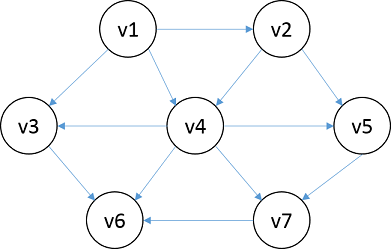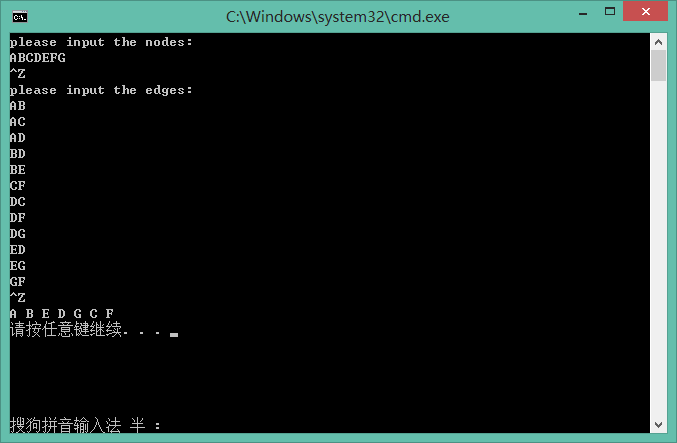基本概念:
拓扑排序是对有向无圈图的顶点的一种排序,若一条路径是从vi到vj,那么在排序序列中vj出现在vi后面。显然,如果图含有圈,那么拓扑排序是不可能的,比如对于圈上的两个顶点v和w,v在w之前同时w又在v之前,在排序中是矛盾的。另外,拓扑排序不是唯一的,比如下面一张图的拓扑排序可以是v1,v2,v5,v4,v3,v7,v6或者v1,v2,v5,v4,v7,v3,v6。

算法设计:
1.简单的拓扑排序
基本思路:找出任意一个没有入边的顶点,然后显示该顶点,并将它和它的边从图中一起删除。然后对图的其余部分应用同样的方法。
具体细节实现:
①把顶点v的入度定义为边(u,v)的条数。
②计算图中所有顶点的入度,保存在数组Indegree中。
③图被读入一个邻接表中。
下面是代码实现,测试数据是上图中的顶点:
#include <iostream>
#include <vector>
#include <cstdlib>
using namespace std;
const int MaxSize = 20;
struct ArcNode{
int adjvex;
ArcNode* next;
};
//头单元数组
template<class Type>
struct VertexNode{
Type vertex;
ArcNode* firstedge;
};
template<class Type>
class Graph{
private:
VertexNode<Type> adjlist[MaxSize];
int vertexNum, arcNum;
Type vertex[MaxSize];
int Indegree[MaxSize];
public:
Graph(){
Type v;
int i, j;
vertexNum = 0;
arcNum = 0;
cout << "please input the nodes:" << endl;
while (cin >> v){
adjlist[vertexNum].vertex = v;
adjlist[vertexNum].firstedge = NULL;
vertex[vertexNum] = v;
Indegree[vertexNum] = 0;
vertexNum++;
}
cin.clear();
cout << "please input the edges:" << endl;
Type a, b;
while (cin >> a >> b){
findNode(a, b, i, j);
Indegree[j]++;//计算各顶点的入度
ArcNode* s = new ArcNode;
s->adjvex = j;
s->next = adjlist[i].firstedge;
adjlist[i].firstedge = s;
arcNum++;
}
cin.clear();
}
void findNode(Type a, Type b, int& i, int& j){
for (int k = 0; k < vertexNum; k++){
if (vertex[k] == a)
i = k;
if (vertex[k] == b)
j = k;
}
}
void TopSort(){
int counter;
Type V, W;
int Index;
for (counter = 0; counter < vertexNum; counter++){
Index = FindNewVertexOfIndegreeZero();
if (Index == -1){
cout << "Graph has a cycle!" << endl;
exit(1);
}
cout << vertex[Index] << " "<<flush;
for (ArcNode* p = adjlist[Index].firstedge; p != NULL; p = p->next){
Indegree[p->adjvex]--;
}
}
}
int FindNewVertexOfIndegreeZero(){
for (int i = 0; i < vertexNum; i++){
if (Indegree[i] == 0){
Indegree[i] = -1;//取出该顶点,下次不再考虑
return i;
}
}
return -1;
}
};
int main(){
Graph<char> g;
g.TopSort();
cout << endl;
return 0;
}
测试结果:

2.改进的拓扑排序
上述算法运行时间长的原因在于对Indegree数组的顺序扫描。如果图是稀疏的,那么在每次迭代期间只有一些顶点的入度被更新,但是,尽管只有一小部分发生了变化,但是在搜索入度为0的顶点时潜在地查看了所有的顶点。
解决方法:使用一个队列,首先,对每一个顶点计算入度,将所有入度为0的顶点放入一个空的队列中。当队列不空时,删除一个顶点v,并将和v邻接的顶点的入度减1,只要有一个顶点的入度降为0,就把该顶点放入队列中。此时,拓扑排序就是顶点出队的顺序。
下面是代码实现,测试数据 同上:
#include <iostream>
#include <queue>
#include <cstdlib>
using namespace std;
const int MaxSize = 20;
struct ArcNode
{
int adjvex;
ArcNode* next;
};
template<class Type>
struct VertexNode{
Type vertex;
ArcNode* firstedge;
};
template<class Type>
class Graph{
private:
VertexNode<Type> adjlist[MaxSize];
int vertexNum, arcNum;
Type vertex[MaxSize];
int Indegree[MaxSize];
public:
Graph(){
Type v;
int i, j;
vertexNum = 0;
arcNum = 0;
cout << "please input the nodes:" << endl;
while (cin >> v){
adjlist[vertexNum].vertex = v;
adjlist[vertexNum].firstedge = NULL;
vertex[vertexNum] = v;
Indegree[vertexNum] = 0;
vertexNum++;
}
cin.clear();
cout << "please input the edges:" << endl;
Type a, b;
while (cin >> a >> b){
findNode(a, b, i, j);
Indegree[j]++;//计算各顶点的入度
ArcNode* s = new ArcNode;
s->adjvex = j;
s->next = adjlist[i].firstedge;
adjlist[i].firstedge = s;
arcNum++;
}
cin.clear();
}
void findNode(Type a, Type b, int& i, int& j){
for (int k = 0; k < vertexNum; k++){
if (vertex[k] == a)
i = k;
if (vertex[k] == b)
j = k;
}
}
int findNode(Type a){
for (int k = 0; k < vertexNum; k++){
if (vertex[k] == a)
return k;
}
}
void TopSort(){
queue<Type> q;
int count = 0;
int Index;
int i;
for (i = 0; i < vertexNum; i++){
if (Indegree[i] == 0)
q.push(vertex[i]);
}
while (!q.empty()){
Type v = q.front();
cout << v << " " << flush;
q.pop();
count++;
Index = findNode(v);
for (ArcNode* p = adjlist[Index].firstedge; p != NULL; p = p->next){
if (--Indegree[p->adjvex]==0){
q.push(vertex[p->adjvex]);
}
}
}
if (count != vertexNum){
cout << "Graph has a cycle!" << endl;
exit(1);
}
}
};
int main(){
Graph<char> g;
g.TopSort();
cout << endl;
return 0;
}
测试结果:

ps:整理自《数据结构与算法分析——C语言描述》





















 1145
1145











 被折叠的 条评论
为什么被折叠?
被折叠的 条评论
为什么被折叠?








